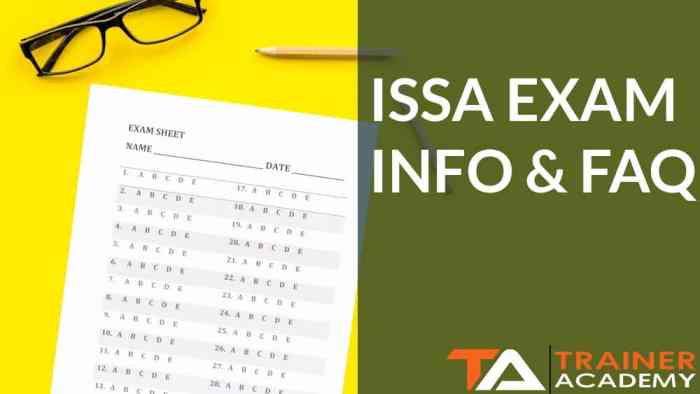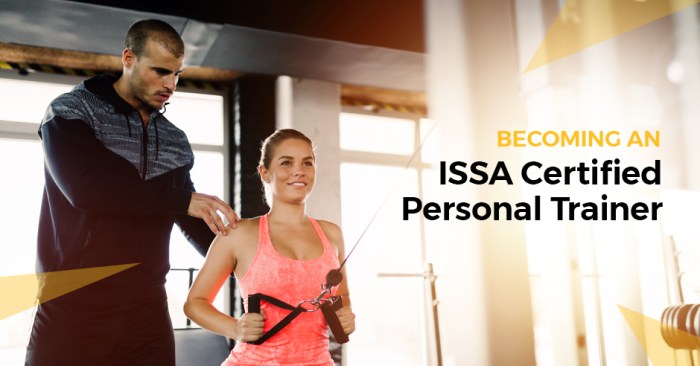Embarking on the journey of the ISSA CPR and AED Final Exam, this comprehensive guide will equip you with the knowledge and skills to respond confidently to cardiac emergencies. Prepare to delve into the crucial techniques, guidelines, and real-life case studies that empower you to make a life-saving difference.
Understanding the intricacies of CPR and AED usage is paramount, as these interventions can significantly increase the chances of survival for victims of cardiac arrest. This exam will test your grasp of the latest guidelines, legal implications, and special circumstances that may arise during these critical situations.
CPR and AED Techniques
Cardiopulmonary resuscitation (CPR) and automated external defibrillation (AED) are life-saving techniques used to respond to cardiac arrest. CPR provides chest compressions and rescue breaths to maintain blood flow and oxygen to the brain and vital organs, while an AED delivers an electrical shock to restore a normal heart rhythm in cases of sudden cardiac arrest.
For your upcoming ISSA CPR and AED final exam, consider utilizing our comprehensive APHG Unit 5 practice test . This resource provides valuable insights into the concepts covered in your exam, enhancing your preparation and boosting your confidence. Don’t miss out on this opportunity to excel in your ISSA CPR and AED final exam.
Steps Involved in Performing CPR
To perform CPR:
- Check for responsiveness: Tap the person and shout their name.
- Call for emergency medical services (EMS): Dial 911 or your local emergency number.
- Position the person: Lay them on their back on a firm, flat surface.
- Open the airway: Tilt the person’s head back and lift their chin to open the airway.
- Check for breathing: Look, listen, and feel for breathing for up to 10 seconds.
- Start chest compressions: Place the heel of one hand on the center of the person’s chest, and place your other hand on top of the first. Push straight down on the chest at a rate of 100-120 compressions per minute.
- Give rescue breaths: After 30 compressions, open the person’s airway again and give two rescue breaths, each lasting about 1 second.
- Continue CPR: Repeat the cycle of 30 compressions and 2 breaths until EMS arrives or the person shows signs of life.
Proper Use of an AED
To use an AED:
- Turn on the AED: Most AEDs will have a power button or switch. Turn it on.
- Attach the pads: Remove the person’s clothing from their chest and attach the AED pads as directed by the device.
- Analyze the rhythm: The AED will analyze the person’s heart rhythm.
- Deliver a shock: If the AED advises a shock, make sure no one is touching the person and press the shock button.
- Continue CPR: After the shock, the AED will instruct you to continue CPR.
CPR and AED Techniques for Different Age Groups, Issa cpr and aed final exam
The techniques for performing CPR and using an AED vary slightly for adults, children, and infants.
| Age Group | Chest Compression Depth | Compression Rate | AED Pad Placement |
|---|---|---|---|
| Adult | 2-2.4 inches | 100-120 per minute | Standard adult pads |
| Child (1-8 years) | 1.5-2 inches | 100-120 per minute | Pediatric pads or adult pads placed on the lower half of the chest |
| Infant (under 1 year) | 1.5 inches or less | 100-120 per minute | Infant pads or adult pads placed on the center of the chest |
CPR and AED Guidelines: Issa Cpr And Aed Final Exam

Performing CPR and using an AED effectively can significantly increase the chances of survival for victims of cardiac arrest. Here are the latest guidelines for performing CPR and using an AED, as well as the importance of seeking immediate medical attention and the legal implications of providing assistance.
Calling Emergency Services
If you witness someone experiencing cardiac arrest, the first step is to call emergency services immediately. This is crucial because it activates the emergency response system and ensures that medical professionals can arrive on the scene as soon as possible.
While waiting for help to arrive, you can begin performing CPR and using an AED if one is available.
Legal Implications
In most jurisdictions, there are laws in place to protect individuals who provide CPR and AED assistance in good faith. These laws, known as Good Samaritan laws, provide immunity from civil liability for any harm caused while providing assistance, as long as it was done within the scope of their training and in accordance with established guidelines.
CPR and AED Training

Completing a CPR and AED training course is a valuable investment in your safety and the safety of those around you. These courses provide the knowledge and skills necessary to respond to cardiac emergencies and save lives.
Types of CPR and AED Training
There are several types of CPR and AED training available, each designed to meet the needs of different individuals and groups.
- Basic Life Support (BLS): This is the most common type of CPR training and is appropriate for laypeople and healthcare professionals. It covers basic CPR techniques, as well as how to use an AED.
- Advanced Cardiovascular Life Support (ACLS): This is a more advanced level of CPR training designed for healthcare professionals who need to be able to provide advanced life support in emergency situations.
- Pediatric First Aid/CPR/AED: This training is specifically designed to teach participants how to provide CPR and first aid to infants and children.
Benefits of CPR and AED Training
There are many benefits to completing a CPR and AED training course, including:
- Increased confidence: Knowing how to perform CPR and use an AED can give you the confidence to respond to an emergency situation.
- Improved skills: CPR and AED training provides you with the skills necessary to perform CPR and use an AED effectively.
- Increased safety: Having the knowledge and skills to perform CPR and use an AED can help you keep yourself and others safe in an emergency situation.
- Lifesaving potential: CPR and AED training can help you save the life of someone who is experiencing cardiac arrest.
Resources for Finding CPR and AED Training
There are many organizations that offer CPR and AED training. Here are a few resources to help you find a training course in your area:
- American Heart Association: https://www.heart.org/en/training
- American Red Cross: https://www.redcross.org/take-a-class/cpr
- National Safety Council: https://www.nsc.org/home-safety/safety-topics/first-aid-cpr
CPR and AED Case Studies
CPR and AEDs have played crucial roles in saving countless lives, with remarkable case studies showcasing their effectiveness. These real-life accounts offer valuable insights into the challenges, successes, and factors that contribute to positive outcomes during cardiac emergencies.
Case Study: Successful CPR and AED Resuscitation
- Background:A 60-year-old man collapsed while playing basketball.
- Intervention:Bystanders immediately initiated CPR and used an AED, delivering three shocks.
- Outcome:The man regained consciousness and was transported to the hospital, where he made a full recovery.
This case highlights the importance of early CPR and AED intervention, as well as the effectiveness of the devices in restoring normal heart rhythm.
Case Study: Challenges in CPR and AED Use
- Background:A 70-year-old woman collapsed in her home.
- Intervention:Family members hesitated to perform CPR due to fear of causing further harm.
- Outcome:The woman died before emergency responders arrived.
This case emphasizes the need for CPR training and public awareness to overcome reluctance and ensure prompt intervention.
Factors Contributing to Positive Outcomes
- Early Recognition:Recognizing the signs of cardiac arrest and initiating CPR immediately.
- Proper CPR Technique:Effective chest compressions and breaths delivered correctly.
- AED Availability:Access to an AED and proper training on its use.
li> Teamwork:Collaboration between bystanders, first responders, and medical professionals.
These factors demonstrate the importance of a comprehensive approach to CPR and AED use, involving training, accessibility, and teamwork, to maximize the chances of successful resuscitation.
CPR and AED in Special Circumstances

CPR and AED techniques may need to be modified in certain special circumstances to ensure the safety and effectiveness of the interventions. These circumstances include drowning, cardiac arrest in a pregnant woman, and cardiac arrest in a child with a congenital heart defect.
Drowning
When performing CPR on a drowning victim, it is crucial to clear the airway of water before initiating chest compressions. This can be done by tilting the victim’s head back and lifting their chin, allowing water to drain from the mouth and nose.
If water is present in the airway, suction it out using a suction device or by performing the Heimlich maneuver.
Cardiac Arrest in a Pregnant Woman
In the case of cardiac arrest in a pregnant woman, it is important to position the woman on her left side to prevent compression of the inferior vena cava, which carries blood from the lower body to the heart. Additionally, chest compressions should be performed higher on the chest, above the level of the woman’s breasts.
Cardiac Arrest in a Child with a Congenital Heart Defect
Children with congenital heart defects may have specific needs during CPR and AED use. It is essential to be aware of the child’s specific condition and any special considerations that may be required, such as avoiding certain compression locations or using different compression techniques.
CPR and AED for Healthcare Professionals

CPR and AED play crucial roles in healthcare settings, where timely intervention can significantly improve patient outcomes during cardiac arrest. Healthcare professionals are required to maintain CPR and AED certification to ensure they possess the necessary skills and knowledge to respond effectively to these emergencies.
Differences Between Lay Rescuer and Healthcare Professional CPR and AED Guidelines
The following table summarizes the key differences between lay rescuer and healthcare professional CPR and AED guidelines:
| Characteristic | Lay Rescuer | Healthcare Professional |
|---|---|---|
| Initial Assessment | Check for responsiveness and breathing | Check for responsiveness, breathing, and pulse |
| CPR Compressions | Push hard and fast at a rate of 100-120 per minute | Push hard and fast at a rate of 100-120 per minute, allowing for full chest recoil |
| AED Use | Follow AED prompts | Follow AED prompts, but may consider advanced airway management and defibrillation techniques |
| Termination of CPR | Continue CPR until emergency medical services arrive or the victim shows signs of life | May terminate CPR if there is no response after 20 minutes of high-quality CPR and defibrillation |
FAQ Compilation
What are the key steps involved in performing CPR?
1. Check for responsiveness and call for emergency services. 2. Position the victim on their back and open their airway. 3. Check for breathing and give rescue breaths if necessary. 4. Start chest compressions at a rate of 100-120 per minute.
When should an AED be used?
An AED should be used when someone is unresponsive, not breathing, and has no pulse.
What are the legal implications of providing CPR and AED assistance?
In most jurisdictions, there are Good Samaritan laws that protect individuals who provide CPR and AED assistance from liability.